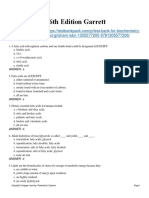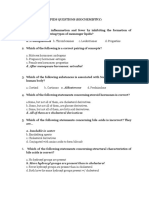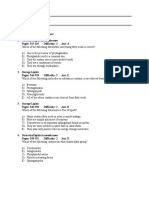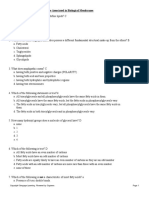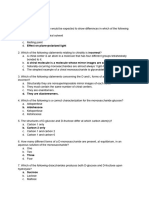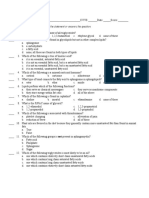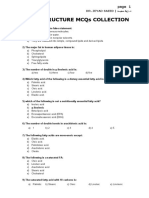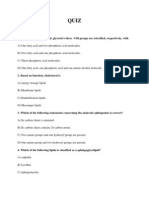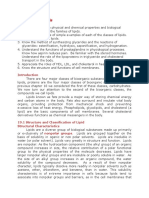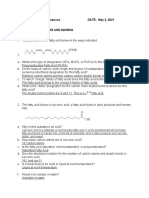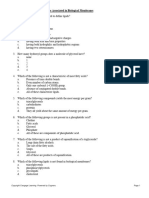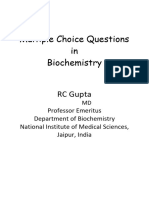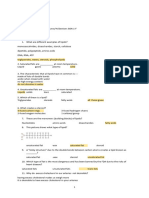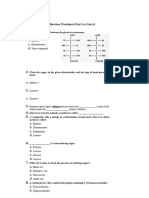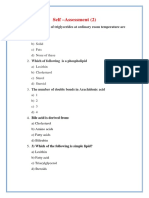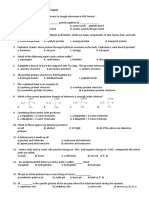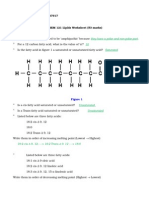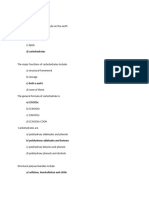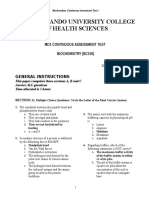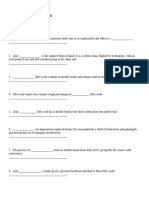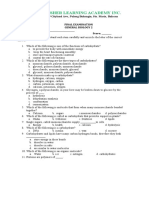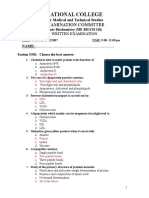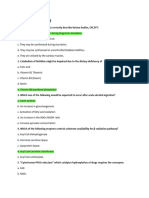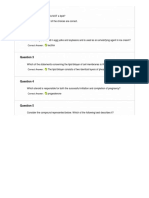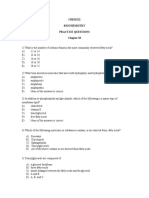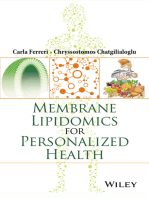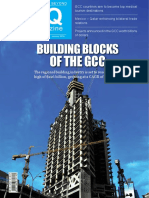0 ratings0% found this document useful (0 votes)
21 viewsLipid Test
Lipid Test
Uploaded by
Hak KubThe document contains questions about lipids and their properties. Lipids include fats, oils, phospholipids, sphingolipids and cholesterol. They serve structural and energy storage functions. Triacylglycerols are composed of a glycerol backbone bonded to three fatty acids by ester linkages. Phospholipids contain a phosphate-containing head group and two fatty acid tails. Cholesterol is an important component of cell membranes and precursor for vitamin D and hormones. Chylomicrons containing dietary lipids are absorbed and transported through the lymphatic system before being transferred to HDL for distribution around the body.
Copyright:
© All Rights Reserved
Available Formats
Download as DOCX, PDF, TXT or read online from Scribd
Lipid Test
Lipid Test
Uploaded by
Hak Kub0 ratings0% found this document useful (0 votes)
21 views4 pagesThe document contains questions about lipids and their properties. Lipids include fats, oils, phospholipids, sphingolipids and cholesterol. They serve structural and energy storage functions. Triacylglycerols are composed of a glycerol backbone bonded to three fatty acids by ester linkages. Phospholipids contain a phosphate-containing head group and two fatty acid tails. Cholesterol is an important component of cell membranes and precursor for vitamin D and hormones. Chylomicrons containing dietary lipids are absorbed and transported through the lymphatic system before being transferred to HDL for distribution around the body.
Copyright
© © All Rights Reserved
Available Formats
DOCX, PDF, TXT or read online from Scribd
Share this document
Did you find this document useful?
Is this content inappropriate?
The document contains questions about lipids and their properties. Lipids include fats, oils, phospholipids, sphingolipids and cholesterol. They serve structural and energy storage functions. Triacylglycerols are composed of a glycerol backbone bonded to three fatty acids by ester linkages. Phospholipids contain a phosphate-containing head group and two fatty acid tails. Cholesterol is an important component of cell membranes and precursor for vitamin D and hormones. Chylomicrons containing dietary lipids are absorbed and transported through the lymphatic system before being transferred to HDL for distribution around the body.
Copyright:
© All Rights Reserved
Available Formats
Download as DOCX, PDF, TXT or read online from Scribd
Download as docx, pdf, or txt
0 ratings0% found this document useful (0 votes)
21 views4 pagesLipid Test
Lipid Test
Uploaded by
Hak KubThe document contains questions about lipids and their properties. Lipids include fats, oils, phospholipids, sphingolipids and cholesterol. They serve structural and energy storage functions. Triacylglycerols are composed of a glycerol backbone bonded to three fatty acids by ester linkages. Phospholipids contain a phosphate-containing head group and two fatty acid tails. Cholesterol is an important component of cell membranes and precursor for vitamin D and hormones. Chylomicrons containing dietary lipids are absorbed and transported through the lymphatic system before being transferred to HDL for distribution around the body.
Copyright:
© All Rights Reserved
Available Formats
Download as DOCX, PDF, TXT or read online from Scribd
Download as docx, pdf, or txt
You are on page 1of 4
1.
A lipid is any substance of biochemical origin that is ;
a. Soluble in water but insoluble in nonpolar solvents.
b. Insoluble in water but soluble in nonpolar solvents.
c. Solvents in both water and nonpolar solvents.
d. No correct answer
2. Which of the following is not a biochemical function classification for lipids?
a. Membrane lipid
b. Messenger lipid
c. Emulsification lipid
d. No correct answer
3. The saponifiable /nonsaponifiable classification system for lipids is based on;
a. Lipid behavior in acidic solution
b. Lipid behavior in basic solution
c. Ability of lipids to react with alcohols
d. No correct response
4. Which of the following statements concerning fatty acids is correct?
a. They are naturally occurring dicarboxylic acids.
b. They are rarely found in the free state in nature
c. They almost always contain an odd number of carbon atoms.
d. No correct response
5. The double bond present in a monounsaturated fatty acid almost always;
a. Is in a cis configuration
b. Involves the second carbon from the carboxyl end of the carbon chain.
c. Involves the second carbon from the methyl end of the carbon chain
d. All of the above
6. In which of the following pairs of fatty acids does the first listed acid have a lower
melting point than the second listed acid?
a. 16:0 acid and 16:1 acid
b. 18:2 acid and 18:0 acid
c. 18:2 acid and 18:3 acid
d. None of the above
7. How many structural subunits are present in block diagram for a triacylglycerol?
a. 2
b. 3
c. 4
d. none of the above
8. How many ester linkages are present in a triacylglycerol molecule?
a. 0
b. 2
c. 4
d. none of the above
9. How many different simple triacylglycerides molecules can be produced that include
glycerol, stearic acid, and palmitic acid as part of their structure?
a. 0
b. 1
c. 2
d. none of the above
10. How many different mixed triacylglycerides molecules can be produced that include
glycerol, stearic acid, and palmitic acid as part of their structure?
a. 0
b. 1
c. 2
d. none of the above
11. Which of the following is a distinguishing characteristic between fats and oils?
a. physical state at room temperature
b. number of structural subunits present
c. number of fatty acid residues present
d. all of the above
12. Unsaturated fatty acid residues are structural components of ;
a. both fats and oil
b. fats but not oils
c. oils but not fats
d. no correct response
13. In terms of human body response to dietary fat, which of the following is considered to
be good fat?
a. saturated fat
b. monounsaturated fat
c. polyunsaturated fat
d. all of the above
14. Linolenic acid and linoleic acid, the essential fatty acid are respectively,
a. 16:1 and 18: 1 fatty acids
b. 18.1 and 18: 2 fatty acids
c. 18:2 and 18: 3 fatty acids
d. none of the above
15. Which of the following are the expected products when a fat undergoes saponification?
a. glycerol and fatty acids
b. glycerol and fatty acids salts
c. fatty acid and fatty acid salts
d. all of the above
16. The effect of partial hydrogenation of a fat or oil is which of the following types of
triacylglycerol reactions?
a. decrease in the degree of fatty acid unsaturation
b. decrease in melting point of the fat or oil
c. increase in the number of fatty acid residues present in a molecule
d. none of the above
17. In the oxidation of fats and oils, which structural part of the molecule is attacked by the
oxidizing agent?
a. carbon – carbon double bonds
b. carbon- carbon single bonds
c. ester linkages
d. all of the above
18. Based on biological function, phospholipid are classified as
a. energy storage lipids
b. membrane lipids
c. messenger lipids
d. none of the above
19. Which of the following types of lipids contain both ester and amide linkages?
a. triacylglycerols
b. sphingophospholipids
c. glycerophospholipid
d. none of the above
20. Which of the following statement about the molecule sphingosine is correct ?
a. two amino group and one hydroxyl group present
b. two hydroxyl groups and one amino group are present
c. two hydroxyl groups and two amino group are present
d. none of the above
21. In terms of the head and two tails model for phospholipids.
a. both tails are hydrophilic
b. both tails are hydrophilic
c. one tail hydrophilic and the other hydrophobic
d. none of the above
22. When the head and two tails structural model is applied to a sphingophospholipid, the
two tails are;
a.both fatty acid residues
b. a fatty acid residue and phosphate group
c. the phosphate group and the glycerol backbone
d. none of the above
23. The number of building blocks present in sphingoglycolipid in which a single
monosaccharide unit is present is ;
a. 2
b. 3
c. 4
d. 0
24. Which of the following types of membrane lipids has a steroid structure?
a. cholesterol
b. sphingoglycolipids
c. sphingophospholipid
d. none of the above
25. Which of the following statements concerning cholesterol is correct?
a. an alcohol functional group is present in ikts structure.
b. the lipoprotein HDL distributes cholesterol to various parts of human body.
c. the cholesterol associated with LDL is often called good cholesterol
d. all of the above
26-30 Discuss the absorption of chylomicrons to HDL (high density lipoprotein) in the body.
You might also like
- Biochemistry 6th Edition Garrett Test Bank DownloadDocument8 pagesBiochemistry 6th Edition Garrett Test Bank DownloadClarence Lee100% (31)
- Lipids Questions W - Answers (Biochemistry) (Bio 024)Document4 pagesLipids Questions W - Answers (Biochemistry) (Bio 024)Vienna GilmoreNo ratings yet
- Lesson 1-The Formation of The UniverseDocument41 pagesLesson 1-The Formation of The UniverseRaymond Escuzar100% (2)
- Capital Med in BriefDocument4 pagesCapital Med in BriefE BNo ratings yet
- Lehninger Principles of Biochemistry Test Bank Ch. 10 PDFDocument8 pagesLehninger Principles of Biochemistry Test Bank Ch. 10 PDFTony Chen0% (1)
- Chapter - 08 - Lipids Membranes-TestDocument10 pagesChapter - 08 - Lipids Membranes-Testendang dian lestariNo ratings yet
- PCP Multiple Choice Problems From BOOKSDocument5 pagesPCP Multiple Choice Problems From BOOKSche.2ndyearNo ratings yet
- Biochemistry: Questions & AnswersDocument19 pagesBiochemistry: Questions & AnswersA-Naeem To'mah Al-sawaieNo ratings yet
- FatsDocument15 pagesFatsahsaanahmadNo ratings yet
- Lipid BDocument6 pagesLipid BKyle Stephen EspañolNo ratings yet
- Ch.8 كيمياء Quiz and Test BankDocument13 pagesCh.8 كيمياء Quiz and Test BankD.3s YTNo ratings yet
- Orca Share Media1567258117004Document10 pagesOrca Share Media1567258117004Monique Eloise GualizaNo ratings yet
- Jawaban Soal Latihan Karbohidrat Dan LipidDocument7 pagesJawaban Soal Latihan Karbohidrat Dan Lipidchildish_baned0% (1)
- Lipid Revision WorksheetDocument7 pagesLipid Revision Worksheetnoorayg.jNo ratings yet
- Lê Mai Xuân Trúc - 1752578Document5 pagesLê Mai Xuân Trúc - 1752578Hoàng PhongNo ratings yet
- TD Lipide Prof CAMARADocument5 pagesTD Lipide Prof CAMARAkone junior yvanNo ratings yet
- Cytology Lab DR Amal2018 SpringDocument4 pagesCytology Lab DR Amal2018 SpringAhmed Ali SofyNo ratings yet
- QuizDocument7 pagesQuizm_linguistNo ratings yet
- Notes C19 121Document21 pagesNotes C19 121Uche KennethNo ratings yet
- Biochemistry Important QuestionsDocument2 pagesBiochemistry Important QuestionsPadmavathi CNo ratings yet
- NAME/S: Myra Mie M. Cabusao DATE: May 3, 2021 Prog/Yr/Sec: 1Bsn3 Lipids: Classification and NamingDocument4 pagesNAME/S: Myra Mie M. Cabusao DATE: May 3, 2021 Prog/Yr/Sec: 1Bsn3 Lipids: Classification and NamingAdrianne BastasaNo ratings yet
- Ch08 QuizDocument5 pagesCh08 QuizcatlovesfoodNo ratings yet
- ch2 Mcqonchemistryoflipids 210927074851Document11 pagesch2 Mcqonchemistryoflipids 210927074851tekalignpawulose09No ratings yet
- .quizassignment.G.What Are Different Examples of LipidsDocument3 pages.quizassignment.G.What Are Different Examples of LipidsKimberly SalarzaNo ratings yet
- Chapter 10 - LipidsDocument21 pagesChapter 10 - Lipidspsmin0124No ratings yet
- Open Revision Worksheet (Unit 1 Till 4) 2Document7 pagesOpen Revision Worksheet (Unit 1 Till 4) 2noorayg.jNo ratings yet
- Self Assessment LipidsDocument2 pagesSelf Assessment Lipidsايمان عبد الشافىNo ratings yet
- Exam On Proteins & Enzymes and Lipids: I. Multiple Choice. Submit All Your Answers To Google Classroom in PDF FormatDocument7 pagesExam On Proteins & Enzymes and Lipids: I. Multiple Choice. Submit All Your Answers To Google Classroom in PDF Formatsylv ackermanNo ratings yet
- Lab - Modelling LipidsDocument1 pageLab - Modelling Lipidsngothitramy1202No ratings yet
- Biotechnologya Todos Los HODocument27 pagesBiotechnologya Todos Los HOHanan AmarkiNo ratings yet
- Lipids WorksheetDocument4 pagesLipids WorksheetNatalie Pemberton50% (2)
- Biochem Final MCQSDocument14 pagesBiochem Final MCQSAsad MirajNo ratings yet
- Weill Bugando University College of Health Sciences: Md1 Continuous Assessment Test Biochemistry (Bc100)Document9 pagesWeill Bugando University College of Health Sciences: Md1 Continuous Assessment Test Biochemistry (Bc100)Fredhope MtongaNo ratings yet
- Test Bank 5Document37 pagesTest Bank 5Sharaf AlkhazanNo ratings yet
- Nutrition Concepts and Controversies 3e 2014 Test BankDocument17 pagesNutrition Concepts and Controversies 3e 2014 Test BankLawrence Golson100% (52)
- Chapter 5 The Structure and Function of Large Biological MoleculesDocument20 pagesChapter 5 The Structure and Function of Large Biological Molecules蔡旻珊No ratings yet
- Biochemistry Stage Exam Main PaperDocument21 pagesBiochemistry Stage Exam Main PaperDkt Pius KpchirchirNo ratings yet
- 1 - MidtermDocument12 pages1 - MidtermJad AwadNo ratings yet
- Multiple Choice Questions For StudentsDocument30 pagesMultiple Choice Questions For StudentsJackielyn EugenioNo ratings yet
- Unit 1 - Biomolecules of Life (LIPIDS Lecture - 2022)Document38 pagesUnit 1 - Biomolecules of Life (LIPIDS Lecture - 2022)Anurag AnandNo ratings yet
- Buenasher Learning Academy IncDocument4 pagesBuenasher Learning Academy IncEl CruzNo ratings yet
- Multiple Choice Questions: B. RibosomeDocument6 pagesMultiple Choice Questions: B. RibosomeChiku MteghaNo ratings yet
- Bio ExamDocument10 pagesBio ExamSereen Abd El-rahmanNo ratings yet
- Quiz of General BiologyDocument35 pagesQuiz of General Biologyhussain AltaherNo ratings yet
- Org Chem II Guiding QuestionsDocument10 pagesOrg Chem II Guiding QuestionsMesfen MeleseNo ratings yet
- Unit 3 Lipids Lesson 3: The Cell MembraneDocument12 pagesUnit 3 Lipids Lesson 3: The Cell MembraneValenzuela Allene GraceNo ratings yet
- H2 Biomolecules QuestionsDocument18 pagesH2 Biomolecules QuestionsWesley TanNo ratings yet
- Rasheed Biochemistry Mcqs PDFDocument8 pagesRasheed Biochemistry Mcqs PDFrasheedahmad962788No ratings yet
- Lipid Review Sheet AnswersDocument2 pagesLipid Review Sheet AnswersAaron Jay MercurioNo ratings yet
- Food and Nutrition MCQ CarboDocument6 pagesFood and Nutrition MCQ CarboShivangi Singh60% (5)
- Mock ExamDocument7 pagesMock ExamKat MercadoNo ratings yet
- Biochemistry Review Questions Chapter 17 Chapter 18 and Chapter 19Document5 pagesBiochemistry Review Questions Chapter 17 Chapter 18 and Chapter 19Jan Fernan Dela VegaNo ratings yet
- Module 3-Test 2 ONLINEDocument13 pagesModule 3-Test 2 ONLINEur.yared21No ratings yet
- Mcqs LipidsDocument27 pagesMcqs LipidsRohit BebartaNo ratings yet
- Chap 10 LipidsDocument14 pagesChap 10 LipidsKristina Moira ArenasNo ratings yet
- Molecular Biology Paper 1 - IB BiologyDocument6 pagesMolecular Biology Paper 1 - IB BiologyJohnathan ChargaffNo ratings yet
- Chapter 10 PRACTICE QUESTIONS WITH ANSWERS PDFDocument5 pagesChapter 10 PRACTICE QUESTIONS WITH ANSWERS PDFloserpantz100% (1)
- Fast Facts: Long-Chain Fatty Acid Oxidation Disorders: Understand, identify and supportFrom EverandFast Facts: Long-Chain Fatty Acid Oxidation Disorders: Understand, identify and supportNo ratings yet
- Crystallization of Lipids: Fundamentals and Applications in Food, Cosmetics, and PharmaceuticalsFrom EverandCrystallization of Lipids: Fundamentals and Applications in Food, Cosmetics, and PharmaceuticalsKiyotaka SatoNo ratings yet
- NESPAK Internship ReportDocument21 pagesNESPAK Internship Reportaalamz93_85491725450% (2)
- Ielts Speaking Part 2 Questions and Answers PDF 40 d33486f7b9Document3 pagesIelts Speaking Part 2 Questions and Answers PDF 40 d33486f7b9Asad MiltonNo ratings yet
- Principal Intuitionistic Fuzzy Ideals and Filters On A LatticeDocument14 pagesPrincipal Intuitionistic Fuzzy Ideals and Filters On A LatticeDalia MuraddNo ratings yet
- The Periodic Table of Elements: MolybdenumDocument1 pageThe Periodic Table of Elements: MolybdenumWi LeongNo ratings yet
- Pertaining To RhythmDocument12 pagesPertaining To RhythmRODALYN M. SOLISNo ratings yet
- Menumbuhkan Minat Baca Masyarakat Melalui Taman Bacaan Masyarakat Berbasis Teknologi InformasiDocument12 pagesMenumbuhkan Minat Baca Masyarakat Melalui Taman Bacaan Masyarakat Berbasis Teknologi InformasiDani TrashNo ratings yet
- Soal Simple Past Tense Kelas XDocument4 pagesSoal Simple Past Tense Kelas XJURIT RATMOKONo ratings yet
- RCD AssignmentDocument3 pagesRCD AssignmentArj AsisNo ratings yet
- BQ MAGAZINE Jan 2016Document43 pagesBQ MAGAZINE Jan 2016mohamed ibrahimNo ratings yet
- Search For The Higgs Boson in The H To W PDFDocument18 pagesSearch For The Higgs Boson in The H To W PDFManuelEduardoAndradePalmaNo ratings yet
- OntentDocument21 pagesOntentKaung Kaung Thant Linn 123No ratings yet
- Amul Distribution SIP ReportDocument31 pagesAmul Distribution SIP ReportAbhishek DeshpandeNo ratings yet
- Take Me With YouDocument2 pagesTake Me With YouVitty OliveiraNo ratings yet
- Q4W1 MATH7 Learning Activity Sheet1Document3 pagesQ4W1 MATH7 Learning Activity Sheet1Millet CastilloNo ratings yet
- UNIT 02 TV Activity WorksheetsDocument3 pagesUNIT 02 TV Activity WorksheetsTriệu HảiNo ratings yet
- 3SV SubmittalDocument2 pages3SV SubmittalBilly Isea DenaroNo ratings yet
- Weighted Moving AverageDocument8 pagesWeighted Moving AveragePam G.No ratings yet
- Why Do I See - Martian Source - Logs in The Messages File - Red Hat Customer PortalDocument8 pagesWhy Do I See - Martian Source - Logs in The Messages File - Red Hat Customer PortalManish TiwariNo ratings yet
- Pass Leader DumpsDocument30 pagesPass Leader DumpsHyder BasetNo ratings yet
- Critical Dimensions of V-Shape PackingsDocument2 pagesCritical Dimensions of V-Shape PackingsKalpana BansalNo ratings yet
- Surface Diagnostics in TribologyDocument13 pagesSurface Diagnostics in TribologyDersein SaraozNo ratings yet
- Suy Sing Offerings 2021 WSDocument2 pagesSuy Sing Offerings 2021 WSJayvee BayaniNo ratings yet
- ZF6HP26 Bi-Metal Bushing Kit - Alto 183625BDocument1 pageZF6HP26 Bi-Metal Bushing Kit - Alto 183625Bporter1980No ratings yet
- Test 2Document23 pagesTest 2Hiếu EuroNo ratings yet
- 136 Yos Online Yabanci Uyruklu Ogrenci Sinavi TR YosDocument5 pages136 Yos Online Yabanci Uyruklu Ogrenci Sinavi TR Yosusmanmughal127790No ratings yet
- Evaluation Form For Non-Printed Instructional Materials: Numerical Value DescriptionDocument4 pagesEvaluation Form For Non-Printed Instructional Materials: Numerical Value DescriptionKai KaiNo ratings yet
- Mean Value Formula For Heat Equation 2Document11 pagesMean Value Formula For Heat Equation 2sahlewel weldemichaelNo ratings yet
- Wepik Revolutionizing Road Infrastructure A Comprehensive Overview of Road Civil Engineering 20231029040210dc0iDocument10 pagesWepik Revolutionizing Road Infrastructure A Comprehensive Overview of Road Civil Engineering 20231029040210dc0isameerkant089No ratings yet
